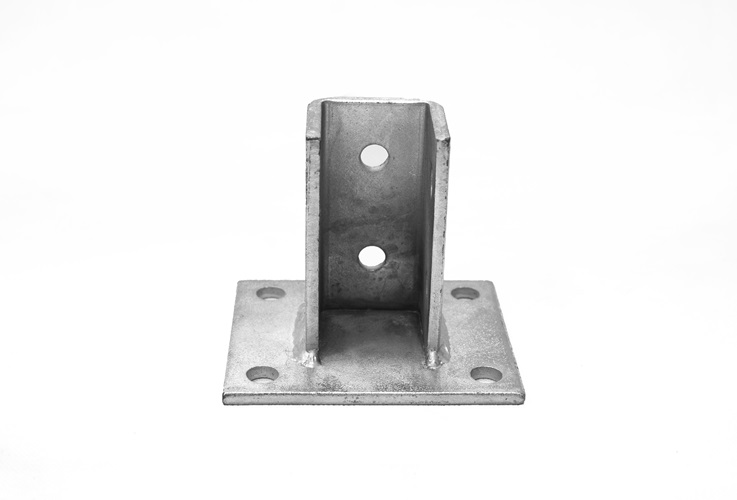

METAR Brand strut channels are versatile structural components widely used in construction, electrical, and mechanical installations for supporting, securing, and organizing various types of piping, electrical conduit, cable trays, and other components. These channels provide a robust framework that facilitates easy assembly and adjustment, making them essential in both standard and complex installations.
Here are the key features and functionalities of METAR Brand strut channels:

Here are the key features and functionalities of base posts for METAR Brand strut channels:
In summary, METAR Brand base posts are essential components within the strut channel system, providing robust support and anchoring solutions for a wide range of mechanical, electrical, and plumbing installations. Their durable construction, compatibility with strut channels and accessories, and versatility in installation make them indispensable for creating reliable support frameworks in diverse industrial and commercial environments.

Here are the key features and functionalities of 2-hole and 4-hole L clamps for METAR Brand strut channels:
In summary, L clamps (both 2-hole and 4-hole) for METAR Brand strut channels are integral components in creating reliable support structures for various mechanical, electrical, and plumbing installations. Their robust construction, compatibility with strut channels and accessories, and versatility in application make them essential for ensuring secure and stable connections in diverse industrial and commercial environments.

Here are the key features and functionalities of cantilevers for METAR Brand strut channels:
In summary, cantilevers for METAR Brand strut channels offer a flexible and efficient solution for extending the support reach and capability of strut channel systems. Their robust construction, compatibility with strut channels and accessories, and versatility in application make them essential components in creating reliable support frameworks for diverse industrial and commercial environments.

Overall, connectors are essential components that maximize the utility and efficiency of METAR strut channels, enabling secure and flexible construction of frameworks, supports, and installations. By choosing the right connectors and accessories, builders and engineers can create robust structures that meet specific project requirements while ensuring long-term reliability and performance.
ANSWERS TO COMMON QUESTIONS
A slotted channel, also known as a strut channel or strut, is a structural system used for supporting electrical, mechanical, and plumbing installations. It features a series of slots or holes along its length to allow for easy installation of components.
Slotted channels are used in a variety of applications including cable management, supporting HVAC systems, mounting electrical equipment, and in framing applications for construction projects.
Slotted channels can be installed using a range of fittings, brackets, and hardware. They are typically mounted to walls, ceilings, or floors, and components can be attached using bolts, nuts, and other fasteners designed to fit the slots.
Yes, slotted channels can be cut to the required size using appropriate cutting tools such as a hacksaw, bandsaw, or a cutoff saw. Ensure to deburr the edges after cutting.
Components can be attached using various fittings like spring nuts, bolts, and brackets that are designed to fit into the slots of the channel. These allow for adjustable and secure attachment of different items.
Slotted channels are commonly made from galvanized steel, stainless steel, aluminum, or fiberglass, depending on the requirements of the application and the environmental conditions.
Yes, slotted channels are designed to be durable and withstand significant loads. The material and finish determine their resistance to corrosion and wear, making them suitable for various environments.
Yes, slotted channels made from corrosion-resistant materials such as galvanized or stainless steel can be used in outdoor applications. Ensure the appropriate material and finish are selected based on environmental exposure.
Regular inspections should be conducted to check for any signs of wear, corrosion, or loose connections. Clean the channels periodically to remove dust and debris, and ensure all components are securely fastened.
Yes, slotted channels can be reused if they are in good condition. Ensure that the channels and all components are inspected for wear and compatibility with the new installation before reuse.
Yes, slotted channels are safe to use when installed and maintained correctly. They provide a robust and adjustable support system for various installations. Follow all safety guidelines and manufacturer instructions.
The weight limits for slotted channels vary based on the size, material, and manufacturer specifications. Always refer to the manufacturer’s guidelines and load tables to ensure the channels are not overloaded.
Yes, slotted channels are designed to comply with various industry standards such as ASTM, DIN, and ISO. Always check the specific product for compliance certifications.
Are there any special regulations for using slotted channels?
Consider factors such as the load requirements, environmental conditions, size, and material. Consult with a supplier or manufacturer to select the appropriate channel and accessories.
Slotted channels can be purchased from hardware stores, electrical supply stores, online retailers, and directly from manufacturers. Ensure you buy from reputable sources to get quality products.
The cost varies based on the size, material, finish, and quantity of the channels, as well as any additional fittings and accessories required. Contact suppliers for specific pricing.
1209, IT Plaza,
Dubai Silicon Oasis, Dubai, UAE